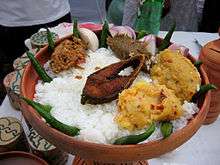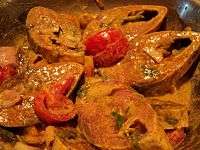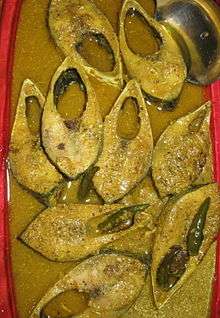Ilish
| Tenualosa ilisha | |
|---|---|
 | |
| | |
| Scientific classification | |
| Kingdom: | Animalia |
| Phylum: | Chordata |
| Class: | Actinopterygii |
| Order: | Clupeiformes |
| Family: | Clupeidae |
| Subfamily: | Alosinae |
| Genus: | Tenualosa |
| Species: | T. ilisha |
| Binomial name | |
| Tenualosa ilisha (F. Hamilton, 1822) | |
| Synonyms | |
| |
Tenualosa ilisha (ilish, hilsa, hilsa herring or hilsa shad) is a species of fish in the herring family (Clupeidae), and a popular food fish in South Asia. The fish contributes about 12% of the total fish production and about 1% of GDP in Bangladesh. About 450,000 people are directly involved with the catching for livelihood; around four to five million people are indirectly involved with the trade.[1] It is also the national fish of Bangladesh.[2]
Common names
Other names include: ilish, ellis, palla fish, hilsha etc. Bengali: ইলিশ: ilish, Odia: ଇଲିଶି , Sindhī: پلو مڇي pallu machhi, Telugu: పులస: pulasa or polasa : Tamil - 'Ullam'. The ilish word is also used in India's Assamese, Bengali-, Odia- and Telugu-speaking regions and in Pakistan's Sindh province. In Gujarat it is known as either modenn or palva. In Iraq it is Called Sboor صبور. In Malaysia and Indonesia, it is commonly known as terubuk. Due to its unique features of oily and tender, some Malays call it 'terubuk UMNO'.
Description and habitat
The fish is marine; freshwater; brackish; pelagic-neritic; anadromous; depth range ? - 200 m. Within a tropical range; 34°N - 5°N, 42°E - 97°E in marine and freshwater. It can grow up to 60 cm in length with weights of up to 3 kg. It is found in rivers and estuaries in Bangladesh, India, Pakistan, Burma and the Persian Gulf area where it can be found in the Tigris and Euphrates rivers in and around Iran and Iraq.[3] It has no dorsal spines but 18 – 21 dorsal soft rays and anal soft rays. The belly has 30 to 33 scutes. There is a distinct median notch in upper jaw. Gill rakers fine and numerous, about 100 to 250 on lower part of arch and the fins are hyaline. The fish shows a dark blotch behind gill opening, followed by a series of small spots along the flank in juveniles. Color in life, silver shot with gold and purple. The species filter feeds on plankton and by grubbing muddy bottoms.[4] The fish schools in coastal waters and ascends up the rivers (anadromous) for around 50 – 100 km to spawn during the South West monsoons (June to September) and also in January to April . April is the most fertile month for breeding of ilish. The young fish returning to the sea are known in Bangladesh as jatka, which includes any ilish fish up to 9 inches long.
Food value
The fish is popular food amongst the people of South Asia and in the Middle East, but especially with Bengalis. It is the national fish of Bangladesh. Bengali fish curry is a popular dish made with mustard oil or seed. It is also popular in India, especially West Bengal, Odisha, Tripura, Assam, Andhra Pradesh and Southern Gujarat and in Mizoram and it is also exported globally.
In North America (where ilish is not always readily available) other shad fish are sometimes used as an ilish substitute, especially in Bengali cuisine. This typically occurs near the East coast of North America, where fresh shad fish having similar taste can be found.
In Bangladesh, fish are caught in the Padma-Meghna-Jamuna delta,[5] which flows into the Bay of Bengal and Meghna (lower Brahmaputra), and Jamuna rivers. In India, the Rupnarayan (which has the Kolaghater Ilish), Ganges, Mahanadi,[6] Chilka Lake,[7] Narmada and Godavari rivers are also famous. In Pakistan, fish are caught in the Indus River. They are also caught in the sea, but some consider the marine stage of the fish as not so tasty. The fish has very sharp and tough bones, making it problematic to eat for some.
Ilish is an oily fish rich in omega 3 fatty acids.[8] Recent experiments have shown its beneficial effects in decreasing cholesterol level in rats [9] and insulin level.[10]
In Bengal, ilish can be smoked, fried, steamed, baked in young plantain leaves, prepared with mustard seed paste, curd, begun (eggplant), different condiments like jira(cumin) and so on. It is said that people can cook ilish in more than 50 ways. Ilish roe is also popular as a side dish. Ilish can be cooked in very little oil since the fish itself is very oily.
| Part of a series on the |
| Culture of Bangladesh |
|---|
|
Rice Bread Fish Sweets Snacks Sauce |
| Religion |
|
Architects Painters Sculptor |
|
Literature History Genres Institutions Awards Writers |
|
Music and performing arts |
|
Monuments |
|
Ilish in culture



- In Andhra Pradesh, the saying goes "Pustelu ammi ayina Pulasa tinocchu", meaning It's worth eating Pulasa/Ilish by even selling the nuptials.
- In Bangladesh and West Bengal during Poila Boishakh (the first day of the Bangali New Year),it is customary to have ilish with panta bhat (Fermented Rice) typically at breakfast.[11][12] The meal is the traditional way to celebrate the Bengali new year. It is the National Fish of Bangladesh.[2] In many Bengali Hindu families a pair of ilish fishes (Bengali: Joda Ilish) are bought on auspicious days, for example for special prayers or puja days like for the Hindu Goddess of music, art and knowledge Saraswati Puja, which takes place in the beginning of Spring or on the day of Lakshmi Puja (The Goddess of Wealth and Prosperity) which takes place in autumn.[13] Some people offer the fish to the goddess Lakshmi, without which the Puja is sometimes thought to be incomplete. In Bengal Ilish is also used during wedding as Tattwa gift. During Gaye Holud tattwa the family of the Groom presents a pair of Ilish to the family of the Bride. However, due to the scarcity of Ilish, nowadays it is replaced by Rohu is West Bengal while the Tradition continues in Bangladesh.
- In Tamil, Hilsa fish is called 'Ullam Meen', and a saying in Tamil 'Ulladhai Vitthu Ullam vangi sapidu'
Ilish production
Five type of ilish can be found worldwide. Yearly ilish caught are 5,000,000 ton. Among them, 50%-60% are caught by Bangladesh, 15%-20% are caught by India, Pakistan and rest 5%-10% are caught by Malaysia, Thailand, China, Vietnam and Sri Lanka.
Overfishing and possible extinction
The species is overfished now. It is becoming rare to land 3 or 2 kg specimens. There has been a consequent price increases and collapsing populations. In the past ilish were not harvested between Vijaya Dashami and Saraswati Puja due to some informal customs of Bengali Hindus as it is the time when the juvenile fish born upstream make their way to the sea during that period. But as disposable incomes grew, wealthier consumers abandoned the old traditions.[14] The paradox is that increasing prices have led to even more over fishing. The advent of finer fishing nets and advanced trawling techniques, and environmental degradation of the rivers, has worsened the situation. Fishermen have been ignoring calls to at least leave the juvenile "jatka" alone to repopulate the species. The fishing of the young jatka is now illegal in many countries. It is thought that some 83,000 seasonal fishermen are employed in catching them [15] and traders are bidding up the price of the fish to exorbitant levels.[16] Furthermore, the changes brought about by global warming have led to a gradual depletion of the ilish's breeding grounds, reducing populations further.[17] The fish is heading towards extinction in certain regions.[18]
See also
- Bangladeshi cuisine
- Bengali cuisine
- List of fish in Bangladesh
- Overfishing
- Environmental impact of fishing
References
- ↑ Siddique, Abu Bakar. "Country's 6th Ilish sanctuary coming soon". Dhaka Tribune. Retrieved 23 May 2015.
- 1 2 Webb, Lois Sinaiko; Roten, Lindsay Grace (2009). The Multicultural Cookbook for Students. ABC-CLIO. ISBN 978-0-313-37559-0.
- ↑
- ↑ "Tenualosa ilisha". FishBase.
- ↑ "'Highway extortion responsible for surge in Ilish prices'". Dhaka Tribune. Retrieved 3 May 2016.
- ↑ "Bioinformatics Centre, National Institute of Oceanography, Goa, India". Biosearch.in. 1 February 2012. Retrieved 22 April 2013.
- ↑ page number 19-20
- ↑
- ↑ Banerjee I, Saha S, Dutta J (June 1992). "Comparison of the effects of dietary fish oils with different n-3 polyunsaturated fatty acid compositions on plasma and liver lipids in rats". Lipids. 27 (6): 425–8. doi:10.1007/BF02536383. PMID 1630277.
- ↑ Mahmud I, Hossain A, Hossain S, Hannan A, Ali L, Hashimoto M (2004). "Effects of Hilsa ilisa fish oil on the atherogenic lipid profile and glycaemic status of streptozotocin-treated type 1 diabetic rats". Clin. Exp. Pharmacol. Physiol. 31 (1-2): 76–81. doi:10.1111/j.1440-1681.2004.03953.x. PMID 14756688.
- ↑ "Feature: Hundreds of thousands pack Bangladesh capital parks to celebrate Bengali New Year 1423 - Xinhua | English.news.cn". news.xinhuanet.com. Retrieved 3 May 2016.
- ↑ "No hilsa this Pohela Boishakh". Dhaka Tribune. Retrieved 3 May 2016.
- ↑ "Ilish... a love story". dna. 24 May 2014. Retrieved 3 May 2016.
- ↑ Mazumdar, Jaideep (1 September 2008). "The Last Ilish Curry". Outlook.
- ↑ "Bid to protect hilsa without 'protecting' the fishermen". The Daily Star. 22 May 2014.
- ↑ Moitra, Kalyan (1 July 2002). "Hilsa may soon become endangered: Experts". Times of India.
- ↑
- ↑
External links
| Wikimedia Commons has media related to Tenualosa ilisha. |
| Wikispecies has information related to: Tenualosa ilisha |
- Hilsa Research in the Bay of Bengal
- Tenualosa ilisha.BdFISH
- "Tenualosa ilisha". Integrated Taxonomic Information System. Retrieved 6 June 2006.
- Mazumder SK, Alam MS (January–March 2009). "High levels of genetic variability and differentiation in hilsa shad, Tenualosa ilisha (Clupeidae, Clupeiformes) populations revealed by PCR-RFLP analysis of the mitochondrial DNA D-loop region". Genet Mol Biol. 32 (1): 190–196. doi:10.1590/S1415-47572009005000023. PMC 3032976
 .
. - Roomiani L, Sotudeh AM, Hakimi Mofrad R (October 2013). "Reproductive biology of Hilsa shad (Tenualosa ilisha) in coastal Waters of the Northwest of Persian Gulf" (PDF). Iranian Journal of Fisheries Sciences. 13 (1): 201–2015.
- Ilish Hut | Ilish Fish Selling Website

.png)
